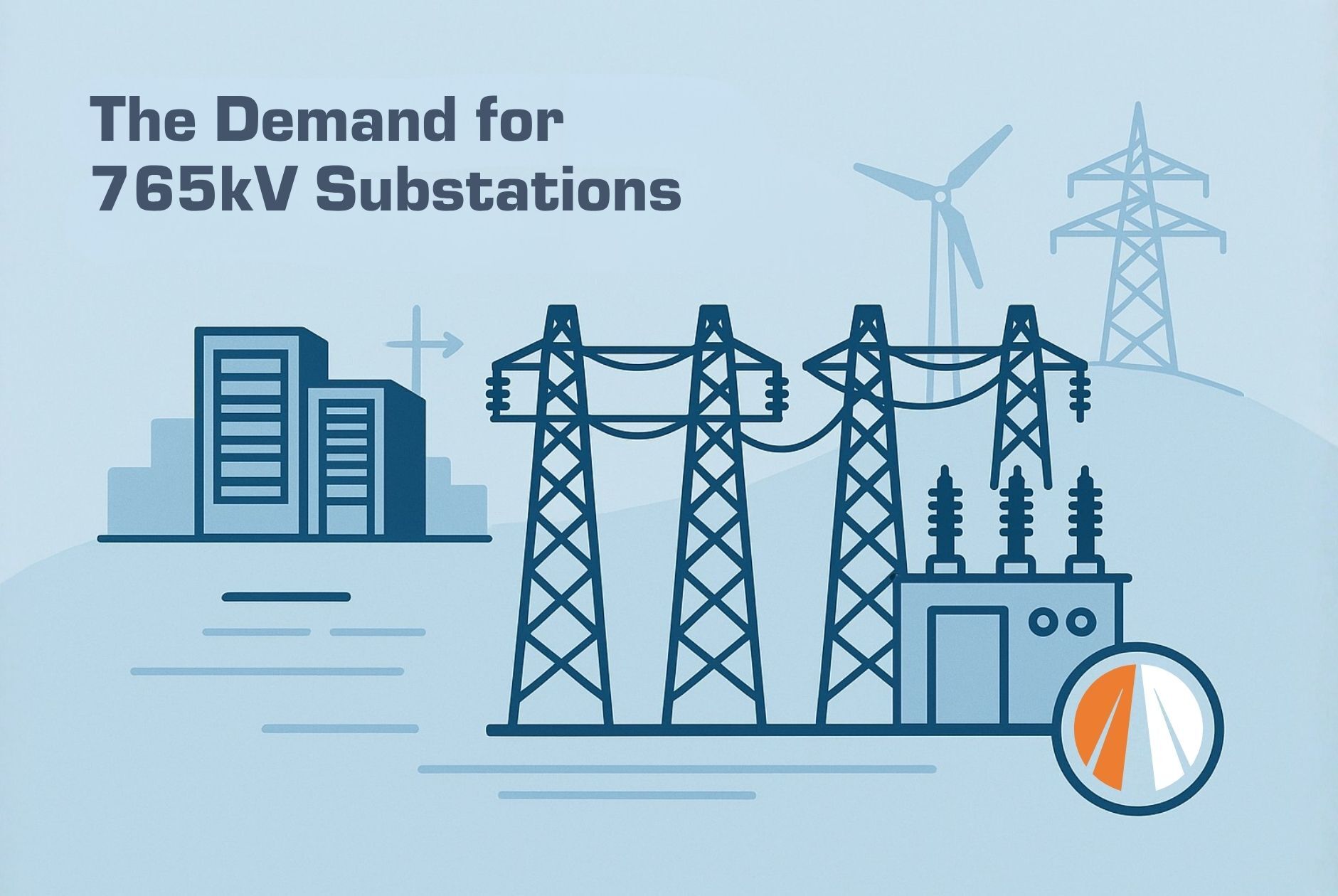Explore how manufacturers like DIS-TRAN Steel are advancing grid resilience by engineering steel structures that enable reliable integration of energy sources—laying the foundation for a stronger, more sustainable grid.
As the grid evolves to handle new patterns of demand and generation, 765 kV systems are becoming a key component of large-scale transmission expansion. What was once limited to a few specialized corridors is now being considered across multiple regions as utilities plan for greater power transfer capability.
The surge in 765kV substation development reflects a pivotal moment for the utility industry — where scale, efficiency, and resilience are no longer luxuries but operational necessities.
Why 765kV Is Back in Focus
For decades, most of North America’s transmission backbone operated at voltages between 138kV and 500kV. These systems served reliably, but they are increasingly strained by new demands: large-scale renewable integration, rapid electrification, increased data center projects, and aging grid reinvestment.
Enter 765kV — a more efficient option for long-distance power delivery compared to 500kV, resulting in lower energy losses and requiring fewer lines for equivalent capacity. Utilities and transmission operators are re-evaluating this high-voltage class as a cost-effective way to expand capacity without multiplying right-of-way constraints.
Federal energy agencies have signaled renewed emphasis on regional transmission planning and cross-state power corridors—highlighting the importance of high-capacity substations as central connection points in a modernized grid. 765kV substations are uniquely suited to anchor these networks, especially as renewable energy zones come online far from load centers.
The Engineering and Logistical Challenge
Working at 765 kV requires a fundamentally different design approach—greater electrical clearances, unique insulation challenges, and the need for heavier, more precisely fabricated steel structures.
Every component, from lattice structures to bus supports, must meet strict electrical, structural, and seismic criteria. The tolerances are tighter, the logistics more demanding, and the coordination between engineering, fabrication, and field construction must be seamless.
Utilities are finding that as they plan new high-voltage sites, collaboration across disciplines — design, fabrication, procurement, and construction — becomes as critical as the materials themselves.
Why Partnership Matters More Than Procurement
In this environment, success depends less on who can deliver steel the fastest and more on who can help plan the project holistically. A 765kV substation’s reliability begins long before fabrication; it starts in the early coordination between utilities, EPCs, and suppliers who understand the nuances of high-voltage design and constructability.
That’s where companies like DIS-TRAN Steel have carved out a unique role — not just as fabricators, but as technical partners. With decades of experience supporting the nation’s utility infrastructure, DIS-TRAN Steel's teams have collaborated on substation structures across the voltage spectrum, including ultra-high-voltage applications.
Their approach emphasizes communication, precision engineering, and on-time delivery, ensuring that structure designs align with equipment layouts, site conditions, and fast-changing project schedules. In a 765kV project, that alignment can mean the difference between a smooth energization and costly rework.
Building for Scale and Reliability
As the industry pushes toward modernization, steel structure design has evolved from a commodity service into an engineering-critical discipline. Fabrication precision, traceability, and fit-up accuracy are no longer optional; they are essential to performance and safety.
DIS-TRAN Steel’s fabrication systems are tailored to meet these standards — not through one-size-fits-all processes, but through adaptable workflows that accommodate the size, geometry, and sequencing unique to 765kV designs. Combined with in-house engineering and close collaboration with its customers, this ensures that every structure arriving on site is ready to perform in one of the grid’s most demanding environments.
Looking Ahead: The Grid of 2035
The momentum behind ultra-high-voltage transmission is just beginning. According to DOE projections, achieving renewable integration and reliability goals by 2035 will require expanding the high-voltage network by tens of thousands of miles—a scale that underscores the need for advanced substation infrastructure. Many of those corridors will depend on 765kV substations as the backbone of interregional power flow.
For utilities and developers, this shift presents both opportunity and challenge: a chance to build a more connected, resilient grid — but one that demands coordination, foresight, and technical rigor at every level.
Industry partners who can blend fabrication expertise with engineering insight will be key to realizing that vision.
A Collaborative Path Forward
The rise of 765kV substations is not just a trend — it’s a signal that the grid is entering a new era of scale and sophistication. Success in this era will hinge on long-term partnerships between utilities, EPCs, consultants, and trusted structure providers who understand both the technical and logistical demands of the work.
As utilities plan for the next generation of transmission, the question isn’t just who can build the structures — it’s who can help build the future of the grid.
Curious? Let’s talk about what’s next for the grid.
The industry-wide shift toward higher-voltage systems is transforming how utilities design and reinforce the transmission backbone. If you’re exploring how to prepare for higher-voltage substations or need a technical sounding board, our team at DIS-TRAN Steel is ready to share insight and experience.
